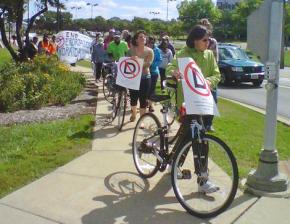Riding for immigrant freedom
Chicago immigrant rights activists took their message to the streets in a Freedom Ride Caravan on Labor Day weekend. reports on the event.
IMMIGRANT RIGHTS activists--calling themselves "Freedom Riders," after the heroic activists who traveled the Jim Crow South to fight segregation in the 1960s--formed a caravan that made its way through the suburbs of Chicago on Labor Day to draw attention to anti-immigrant policies.
About 40 people took part in the caravan of bicycles and cars over the three-day weekend, and brought solidarity and support to the isolated immigrant communities in the conservative DuPage and Kane Counties just west of Chicago.
The journey was organized by the Moratorium on Deportations Campaign (MDC), a grouping of different grassroots organizations and individuals whose goal is to win an executive order from President Barack Obama for a moratorium on deportations. The Freedom Ride was a coordinated effort by MDC and local activist groups, congregations and communities to draw attention to anti-immigrant practices like the Secure Communities program (S-Comm).
The riders not only wheeled their way through a grueling three-day bike marathon but also through the harsh realities of immigration enforcement policies.

S-Comm is an Immigration and Customs Enforcement (ICE) program that requires participating local and state law enforcement agencies to share the fingerprints of detainees with immigration databases. Detainees with criminal backgrounds are then separated into three different threat levels.
This program supposedly facilitates the removal of the most dangerous "criminal aliens" (level 3) and not the hardworking, underpaid, socially unrepresented workers without proper documents. This idea is, of course, laughable when one considers ICE's track record of workplace raids and family separations, not to mention the facts about what has already happened in places where S-Comm has been implemented.
The best-known example of how blatantly racist this type of immigration enforcement can be is Maricopa County in Arizona. Fifty-four percent of the immigrants that Sheriff Joe Arpaio and his cronies have deported using S-Comm have no criminal record, according to a Freedom of Information Act request by the Center for Constitutional Rights and the National Day Laborer Organization Network.
However, Arpaio isn't the worst example. Maricopa County actually ranks 17th on a list in which Travis County in Texas is number 1, averaging 82 percent of non-criminal S-Comm deportees. Nationally, during fiscal year 2009, 22 percent of S-Comm deportees where non-criminals; in 2010 so far, this figure has risen to 32 percent. Furthermore, 79 percent of the people deported through S-Comm were non-criminals or brought in for lower-level offenses, like traffic violations.
CHICAGO HAS a "sanctuary city" ordinance that forbids local enforcement from implementing federal immigration law. The Freedom Riders' Caravan was, in part, a way to reach out to the immigrants trapped in these so-called "secure communities."
A small rally for the DREAM Act in the Village of Schaumburg was the starting point for the freedom riders on September 3. They held signs and chanted outside State Rep. Melissa Bean's office, demanding passage of the DREAM Act.
With a chilly wind at their backs, riders pedaled south to DuPage County, where the following day they joined local activists and community leaders in protest. Activists stood outside the courthouse and demanded that the county opt out of Secure Communities and the 287(g) program, which deputizes local officers as ICE officials.
The crowd later marched through the main commercial strip, chanting like "Undocumented! Unafraid!" and "Racist laws don't make us safe."
The riders then cruised, with loud honks of appreciation from the passing traffic, toward the town of Bolingbrook, where a local group, Warehouse Workers for Justice, organized a visit through Chicago's biggest intermodal distribution facility.
The landscape was filled with the sprawl of warehouses, where most of the workers are temporary and underpaid immigrants and minorities. A majority of those workers live in the riders' next stop--the city of Joliet. Welcomed by members of a local Catholic church, the freedom riders and local activists handed out know your rights literature, petitions and posters that read, "Moratorium Now" to about 500 worshipers from the immigrant community.
The next target was Homer Glen, where township officials, some who are members of the conservative Tea Party movement, recently passed a racist English-only ordinance. The MDC planned a picnic at a park, where in front of cameras and local youth, Freedom Riders wrote messages of tolerance and solidarity using chalk on the sidewalk.
But this was too much for Homer Glen, and the Kane County Sheriff's department sent in five squad cars to demand that the riders "clean it off." Following the peaceful tactics of the civil rights movement, the riders ignored the demand and continued their journey.
Later that day, in Little Village, one of Chicago's largest immigrant neighborhoods, riders were welcomed home with warm honks and food.
The counties of Kane and DuPage have been crucial labor hubs and have flourished with the aid of hard-working immigrants and natives together. But the Obama administration disagrees, and has made criminals of our hard-working neighbors with punitive deportation enforcement. This has only made the far right more confident to initiate further attacks on immigrants' rights.
Even with this relatively small event, the Freedom Riders lived up to the name--and are not alone, as others join the movement for legalization for all. These type of actions are sowing the seeds for broader struggles to come. As civil rights activist James Farmer, leader of the Congress of Racial Equality, once said, "Words are not enough. There must be action."


